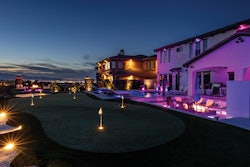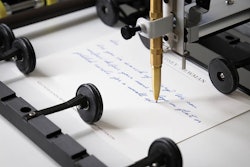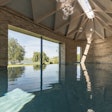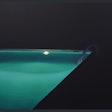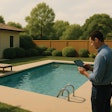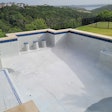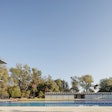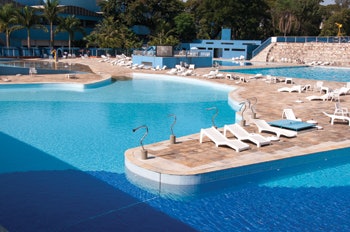
There over 10 million commercial and residential pools, most of them hemorrhaging energy and money. This is a great opportunity.
Over the next five years, an estimated 8 billion dollars* will be spent by pool owners upgrading to more-efficient pumps, heaters, filtration systems, plumbing, covers and sanitation. The actual figure may be higher when it’s all said and done because there are so many forces driving the change. These include pool owners (once they see the savings), utilities, state and local governments and especially the contractors that will be paid to perform the work.
What we’ve known for a long time inside the pool making and servicing industry — that the swimming pool can be made to use a heck of a lot less energy — is becoming common currency in the society as a whole. Word has been trickling out for some time, but that trickle has become an irresistible stream.
Each new year brings more support from state legislators, code committees and utilities. At the same time, manufacturers, some of whom stumbled out of the gate as the movement first got started, have been perfecting their products and developing clever new ones. But most importantly, word of mouth from customers that have more money in their operating budgets and checking accounts is percolating out through the pool community.
All to our benefit, because in order to create the bright new age of pool efficiency, in which millions of private and public pools pump slow through wide conduit, and heat and filter and sanitize efficiently, a great many renovations and upgrades will have to be performed for profit by our colleagues who pursue this work.
People like Mark Caldwell, general manager at Pool Services Corp., Myrtle Beach, S.C. In the last year, Caldwell has closed on 12 energy upgrade projects consisting of more than 30 VFDs, with another 190 out on proposal.
With something like 2,700 commercial pools, Myrtle Beach is a great market for energy upgrades. As a rule, commercial pools are the low hanging fruit of the efficiency conversion trade. When they waste energy, they waste a lot of it. So their savings are huge, the rebates from utilities are hefty, and the margins for the renovator are quite satisfactory.
“We’ve done quite well with it and are really very excited about it,” Caldwell says. “At the same time, in the last year we’ve reduced energy consumption in the area by over 1.2 million kWh per year.”
It’s such a good deal, at times the pitch sounds almost too good to be true, Caldwell adds. “For instance, I’m working on a project with two lazy rivers right now. They have six 15-horsepower pumps, using two at a time. What we found is that we can run three pumps, reduce the speed of each one by about 35 percent, and still provide the same flow as they had with two — while using less energy than it takes to run just one.
“That’s the part that catches everybody by surprise, when I tell them that I can run the lazy river at the speed that they know will work, for less energy than it takes to run one pump.
“The cost savings is $21,300 per year. The rebate that [local utility] Santee Cooper just approved is $21,000, and the energy savings is 270,000 kWh per year. This is what’s called a win-win.”
Caldwell makes his money on sales of the units, not consulting fees. But once he has impressed the client with the amount of money he’ll save for them in a year, other opportunities are often forthcoming.
“Once you’re saving somebody $21,000 a year in energy, and you’ve gotten them a $21,000 rebate, well, at that point you’ve got some credibility.”
Audits We Like
At a slightly higher latitude than Caldwell, but on the opposite coast, another energy conversion warrior, Gary Gockel, is plying the efficiency conversion trade just north of San Francisco. Gockel started in the industry in 1973 working for Rudy Jacuzzi. In just under four decades of pool and spa industry work he’s done just about everything, but now he specializes in commercial pool energy upgrades. A lot of his clients are schools and Olympic-size public pools.
“My model is different than most,” he says. “I have no employees; I’m a sole proprietor. Some of my colleagues have companies with 300 commercial pools on service routes, so it’s easy for them to go to the customer they’ve had for a while and say, ‘You know, I really want to bring to your attention the possible savings of going with an equipment upgrade.’ But for me its just word of mouth.”
Gockel performs a holistic pool energy usage audit, which usually takes about four hours, using a 3-phase power meter to take readings, and then takes a day to analyze results. These measurements go into a report that spells out exact current expenditure, and estimates the savings Gockel’s recommended equipment would provide.
It’s a comprehensive analysis, he notes, as opposed to a simple pump replacement. “Some people think all you have to do is put in a VFD and your done, but that’s just the minimum savings. You really have to look at the whole system.
“For instance, as you lower the speed of the pump and the pressure goes down, suddenly you find you no longer have flow to the chlorinator, and that means you don’t have sanitation and pH control.
“There are all kinds of things you find. Many times the piping to the heater is inch and a half while everything else is two and a half inches, or there are problems at the filter, things like that.”
In the savings estimates, it’s important not to overpromise, he says: “The industry makes all these claims of 90 percent savings, but if you tell a customer they’re going to get 90 percent savings and they don’t, that’s a real problem.
“I always underestimate my savings, and give them a number I absolutely know I can make. That way, after it’s done, I can say, “Well, I said I’d get you down to 40 dollars a month, and it’s really only 30 dollars a month.’ And then you come out looking good. On the commercial side, where we’re talking thousands of dollars a month, that makes you a big hero.”
Stand And Deliver
Of course, there’s more to being a hero than just putting out a shingle. There are reasons that only a small percentage of the industry is involved in the efficiency upgrade game. Some are too busy making a living. Others haven’t mastered the technical know-how or the basics of flow. And some just can’t deliver the pitch with confidence.
Credibility is a big part of it, Caldwell says. He was well established in the Myrtle Beach area when he started looking at energy upgrades, but he did his homework before jumping into the energy conversion business, and believes that paid off.
“I think you need to be prepared to put in a year’s worth of work before you make your first sale, because you need credibility with the customer. You need to know what you’re doing, and how VFDs work. You need to understand pool hydraulics, and that takes training and hard work.”
Gockel puts it simply: “Knowing how much money they can really save, being able to say it with confidence, and at the end of the day, being able to produce that savings — that’s the trick for this business.”
Follow through is just as important, as rebates — a crucial component of the deal — are dependant on an arduous verification process. “There is a ton of paperwork,” Caldwell says. “The utility doesn’t give away all this money just because I say so. They verify every number I give them. They send out an independent group to re-measure everything that I do and verify every number and they pay the rebate off the verified savings.”
Start With A Course
So you know pools, you’ve got some experience and a good understanding of pool equipment, and you get the main point — that there’s profitable work for people who can produce energy savings, and there’s a lot of energy out there to be saved in the pools of America. So where do you start?
A good place might be the Certified Aquatic Energy Auditor course offered by FPSIE, Gockel says.
“I was in the very first class from [course instructor and designer Michael Orr, director of education for FPSIE]. They teach a lot of good information, and it’s a good primer for people who are serious. It gives people some confidence to get their feet wet, and go ahead and try one, and see if they can do this type of thing. It gives them some basics that they can start working with.”
“It teaches people how to take the crucial basic measurements which are essential to an audit,” Orr says. “These measurements allow the auditor to speak with confidence and assurance, and they provide pool owners with cold, hard proof.
Students taking the course also learn what things to look for in the backyard, Orr says, “such as an oversized pump, or perhaps a pump that is drawing more current than the main label on the plate. Or maybe there’s a very high vacuum reading because something is clogging the line.”
Orr says that when it comes to changing over America to energy efficiency, home energy auditors will likely be the principal players, and most pool energy audits will be part of an overall energy audit for an entire property including the home.
“For pool people wanting to get their share of this market, either they’re going to have to learn how to audit, or they will have to make alliances with auditors, so they can do the repair or installation part,” Orr says.
Regardless of the business model, the opportunity in pool energy conversion is huge. Still, it’s not for everyone. Many people in the pool industry can’t wire a 2-speed time clock, but for those with a technical mind and an “affinity” for pumps, who can say the phrase “pool engineering” without blushing, there is a bright opportunity in the pool energy revolution. Eight million pools will receive an energy trim in the next five to 10 years, and that changeover will be a profitable one for the people who can execute it, one pool at a time.
Comments or thoughts on this article? Please e-mail [email protected].
* Estimate based on 8 million pools times $1,000 per pool upgrade. For more details, see sidebar.
How Much Work Is Out There?
Anyone with personal experience with the American pool market can say with assurance that there are a lot of pools that could use an efficiency upgrade.
For years and years, pools were built with little regard for the amount of energy they might use, with huge pumps, skinny pipes and poor choices for system components. The bad news is that we wasted a lot of our country’s resources and gave customers, both commercial and residential, a great pain in the wallet.
The good news is that a large market for retrofit was created. Michael Orr, director of education at FPSIE, reckons the size to be about $8 billion.
“We did an estimate of the number of pools that would need some type of retrofit, out of the 12 million or so inground swimming pools, and we came up with at least 8 million of them.
“And you’re looking at somewhere around $2,000 per pool, you can do the math, that’s $16 billion. We figure that about $8 billion of that will take place over the next five years.
“And most of the utilities are under pressure to help — especially here in California where they have to meet new requirements. By 2020, they have to have 33 percent of their power from renewable sources or get credit for conservation programs. So the utilities are highly motivated to get this done.”
Currently residential rebates are $100 for the homeowner and $200 for the installer, while commercial rebates are much higher. These can range into five figures if the energy savings are big enough.
The millions of rebate dollars paid by utilities strike some people as odd, considering that the utility is in effect offering incentives for customers to use less of it’s product.
But the choice for the energy company is either encourage conservation or build more power plants, which is becoming more difficult and expensive every year. They prefer to avoid that option.
“If they can pay an insignificant rebate [by comparison to the costs of building a plant] to reduce the use, they’re happy to do that,” Caldwell says. — S.W.
Change The Motor, Keep The Impeller
When swapping out a pump for a more-efficient variable speed or two-speed model, it’s the motor and controller that are really the target for replacement, but a perfectly good impeller usually gets tossed out in the bargain. According to Gockel, two manufacturers offer a more “efficient” option for basic pools.
“US Motor has a variable-speed motor replacement with time clock called ‘EcoTech’ where you just replace the single-speed motor with a variable-speed motor and keep the same impeller. The controller senses this and readjusts all the power loading, and it’s good for single speed pumps, ¾-hp all the way up to 3-hp. This means you don’t have to replumb for a new pump, you just swap out the motor. So it saves you both time and money. I’ve done about 20 of these things, and it’s great. A.O. Smith has a similar product, the V-Green variable-speed motor replacement.” — S.W.



























